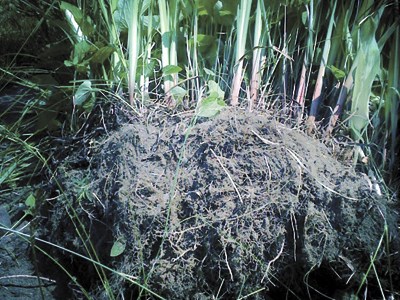I love going to the greenhouse and filling my cart full of plants. Who doesn’t? What’s even more satisfying, though, is dropping by a friend’s and unexpectedly leaving with a box of plants from their backyard.
Shared plants are such treasures. I’ve been itching for some bee balm for over a year now, and could have easily just gone out and bought some. But I waited. And good thing — for a visit last week ended up with a good sized portion of a flaming red bee balm so tall and lithe that I grinned the whole way home, imagining what I would need to rearrange in the garden to suit such a tall beauty.
My garden is full of shared plants. I’ve got Japanese Iris from my mom who got them from my grandmother when she was alive. And over the years, I’ve acquired a number of others, from friends who shared bits of this and that.
I have a rule of thumb that goes like this: if you receive something from someone’s garden, share with them something from yours. Make it reciprocal, I say.
Depending on the type of plant, you’ll want to know what you’re doing. You want it to survive the move, particularly if you’re transplanting midday in July.
But for a regular job, let’s say a Hosta, you’ll want to position your shovel at an angle so it digs wide around the top, but goes under the base, like a scoop. A pointy spade works best for getting through the roots, particularly if the plant is well established.
Get all the way around, trying your best to bring up a good portion of the roots and soil and gingerly lift it up. This will provide you with an opportunity to split your plant even more. You’ll feel as though you are cutting through its life-source, but a sharp thrust through the root base must be done incisively and without regret.
If you are happy with the size of your plant, make sure the hole you are moving it into is twice the size of the width of its roots. A good handful of bonemeal tossed into the hole will enable the roots to grow. If you’re like me and don’t remember to add it in after you pat the last bit of earth down over the plant, you can always toss some on the surface and let the rain do its job of diluting it into the soil.
You’ll also want to give your new lovely a big long drink. I suggest a douse directly after the move. You can give it a longer drink at night when the sun won’t singe the tender shocked greens.
Following that, you should have yourself a healthy addition. A perennial gardener’s bane are perennials that feel entitled to grow where and how big they please. Sharing is the best way to ensure your garden’s health and beauty.
Anne Boulton is an avid gardener who lives in Sudbury. Contact her at [email protected] or visit her blog at boultonanne.typepad.com/greenboots.
- Posted by Vivian Scinto
Join Sudbury.com+
- Messages
- Post a Listing
- Your Listings
- Your Profile
- Your Subscriptions
- Your Likes
- Your Business
- Support Local News
- Payment History
Sudbury.com+ members
Already a +member?
Not a +member?
Sign up for a Sudbury.com+ account for instant access to upcoming contests, local offers, auctions and so much more.
